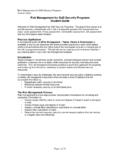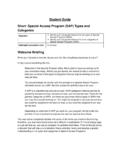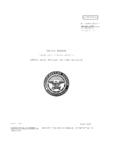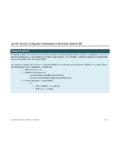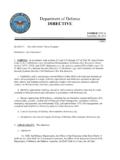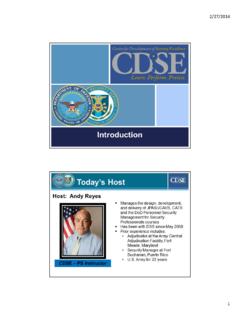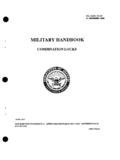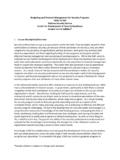Transcription of Introduction to Risk Management Framework Course …
1 Student Guide Introduction to the Risk Management Framework (RMF) Course Table of Contents Introduction to the Risk Management Framework (RMF) Course .. 3 RMF Topics .. 3 Course Objectives .. 3 Transformation to the RMF .. 4 Policy Alignment .. 4 Policy Partnerships .. 4 RMF Guidance Alignment .. 4 DIACAP Transition to 5 RMF Governance .. 5 RMF Governance Overview .. 5 DoD RMF Guidance .. 6 DoD RMF Guidance - Tier 6 DoD RMF Guidance - Tier 6 DoD RMF Guidance - Tier 7 DoD Information Technology .. 7 DoD Information Technology Defined .. 7 Reciprocity .. 7 Implementation Guidance .. 8 RMF Implementation Guidance .. 8 RMF Step 1 .. 8 Sample Control Baseline .. 8 RMF Step 2 .. 9 Introduction to the Risk Management Framework Course Student Guide July 2014 Center for the Development of Security Excellence 2 Security Control Catalog (NIST SP 800-53) .. 9 RMF Step 3 .. 9 RMF Step 4 .. 10 RMF Step 5 .. 10 RMF Step 6.
2 10 RMF and DoD IT Acquisition .. 11 RMF in DoD Acquisition Cycle .. 11 RMF Transition Timelines .. 11 Conclusion .. 11 Knowledge Checks .. 13 Answers to Knowledge Checks .. 16 Introduction to the Risk Management Framework Course Student Guide July 2014 Center for the Development of Security Excellence 3 Introduction to the Risk Management Framework (RMF) Course Paul: Hey M a r y, did you hear that DoD is adopting something called RMF? What is that? Mary: Oh, Hi Paul. Sure, I was just working on developing some training for RMF. RMF stands for Risk Management Framework which is a new method of conducting the Certification & Accreditation process for DoD Information Systems. Paul: guess that means big changes for us, huh? Mary: Well, Yes and no. The changes are an evolution of existing practices, but they re also a step forward. They advance the practice of Information Assurance at DoD.
3 The changes recognize cyber defense as an integral component of Information Assurance policies and procedures government-wide. Paul: So, I guess Certification and Accreditation is no longer just about checking off boxes for compliance. Mary: You re right. DoD has recognized that the threat environment demands a more mature and integrated process. Understanding RMF is mission critical for us all. Here let me show you what I was just working on. Paul: Sure. R M F To p i c s The Risk Management Framework ( RMF) is the common information security Framework for the Federal Government. RMF aims to improve information security, strengthen the risk Management processes, and encourage reciprocity among federal agencies. The topics we will cover include: Policies and regulations that govern the Department of Defense (DoD) Transition to RMF Categories of DoD Information Technology affected by RMF The six steps in the implementation of RMF RMF applicability to the DoD Acquisition Process RMF Transition Timelines Course Objectives At the end of this Course you will be able to: Identify policies and regulations that govern the DoD Transition to RMF Define DoD Information Technology affected by RMF Understand the implementation of RMF Please allow 30 minutes to complete this Course .
4 Follow the on-screen instructions to advance through the Course . You will also find options for Course resources and transcripts of the Course material. After each lesson is a short review to immediately reinforce several key points of that lesson. You will need to complete each review before you are permitted to go to the next lesson. Introduction to the Risk Management Framework Course Student Guide July 2014 Center for the Development of Security Excellence 4 To receive a certificate of completion for this Course , you must also take the final exam. The exam is located in STEPP. RMF Introduction Let s begin by looking back to see how the DoD transformation to the RMF started. Everybody knows that information technology and systems are integral to operations at DoD. While these systems have brought great benefits to the battlefield and the office, they also represent vulnerability.
5 DoD systems are subject to threats that can have adverse effects on organizational operations and assets, individuals, and the Nation. These threats can compromise the confidentiality, integrity, or availability of information processed, stored, or transmitted by DoD systems. Transformation to the RMF In an effort to counter these threats, DoD has transformed its cybersecurity policy by employing a joint task force in its evolution from the Defense Information Assurance Certification & Accreditation Process (DIACAP) to the adoption of new Cybersecurity policy under DoDI and the RMF under DoD The RMF, supported by the National Institute of Standards and Technology (NIST) 800 series publications (already in use by other federal agencies under the Federal Information Security Management Act) provides a structured, yet flexible approach for managing risk resulting from the incorporation of information systems into the mission and business processes of an organization.
6 Even with the changes, DoD will continue to follow the DoD 8500 series documentation for cybersecurity policy. Policy Alignment DoD is not reinventing the wheel, simply aligning cybersecurity and risk Management policies, procedures, and guidance with Joint Transformation NIST documents to create the basis for a unified information security Framework for the Federal Government. Policy Partnerships DoD participates in Committee on National Security Systems and NIST policy development as a vested stakeholder with the goals of a more standardized approach to cybersecurity and to protect the unique requirements of DoD missions and warfighters. RMF Guidance Alignment The NIST and CNSS policy partnerships ensure that DoD RMF guidance is aligned with NIST and CNSS standards and guidance. Introduction to the Risk Management Framework Course Student Guide July 2014 Center for the Development of Security Excellence 5 DoD is committed to making the transition to RMF seamless and, to that end, will be deploying an RMF Knowledge Service.
7 Many of you may be familiar with the DIACAP Knowledge Service. The RMF Knowledge Service is currently being developed and will be housed in a new portal as soon as the initial content is finalized. Once content has been deployed, a link to the new portal will be provided on the main DIACAP Knowledge Service splash page at the website identified on your screen. The DIACAP Knowledge Service will remain online to support current systems. DIACAP Transition to RMF The DoD RMF supports the transition from a DIACAP approach to an enterprise-wide decision structure for cybersecurity risk Management . Although some of the terminology and processes may change (for example Mission Assurance Categories will now be known as Impact Values) the concepts behind them remain the same. Under the RMF, technical and non-technical features of DoD Information systems will be comprehensively evaluated in the intended environment. This allows an Authorizing Official (AO), formerly referred to as the Designated Approving Authority, to determine whether or not the system is approved to operate at an acceptable level of security risk based on the implementation of an approved set of technical, managerial, and procedural countermeasures or mitigations.
8 We ll explore the specifics of these controls under the Implementation Guidance portion of this Course . So while it sounds complex, the RMF builds on existing information assurance policy by providing a structured, yet flexible approach for managing risk. RMF Governance Now let s talk about the governance of the RMF under the DoD. RMF Governance Overview Governance of RMF is strategic in nature and recognizes that managing risk from the operation and use of information systems is critical to your organization's goals and mission. Risk Management should be considered within the enterprise architecture. It requires an organization-wide perspective to ensure that day-to-day operations are conducted within a secure environment commensurate with risk. Attacks on information systems today are often well-organized, disciplined, aggressive, well-funded, and extremely sophisticated. Successful attacks on public and private sector information systems can result in harm to national and economic security interests.
9 Given the significant danger of these attacks, all individuals within the organization must understand their responsibilities for managing the risk from operating information systems that Introduction to the Risk Management Framework Course Student Guide July 2014 Center for the Development of Security Excellence 6 support the mission/business functions of the organization, and take responsibility for risk consequences and mitigation. DoD RMF Guidance The complex, many-to-many relationships among mission or business processes and the information systems supporting those processes require a holistic, organization-wide view for managing risk. A holistic approach requires the Management of risk at both the enterprise-level and system-level. This approach takes into account the organization as a whole, including strategic goals and objectives and relationships between mission/business processes and the supporting information systems.
10 Organizational culture and infrastructure should also be considered. The security controls and safeguards selected by the organization must take into account: Potential mission or business impacts Risk to organizational operations and assets Individuals Other organizations The Nation These roles and responsibilities have been delegated enterprise-wide and are arranged into tiers. DoD RMF Guidance - Tier 1 Tier 1 is the Office of Secretary of the Defense and it addresses risk Management at the DoD enterprise level. Key governance elements in Tier 1 are: The DoD Chief Information Officer who Directs and oversees the cybersecurity risk Management of DoD IT, The DoD Senior Information Security Officer or SISO who: - Represents the DoD CIO, - Directs and coordinates the DoD Cybersecurity Program, and - Establishes and maintains the DoD RMF, and - The DoD Information Security Risk Management Committee that performs the DoD Risk Executive Function.

